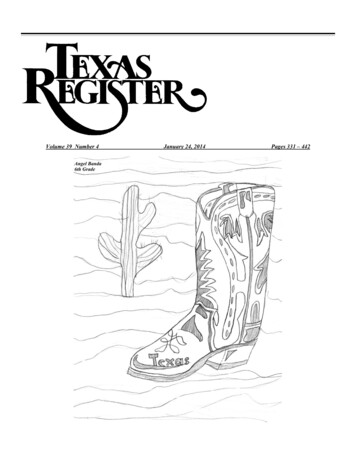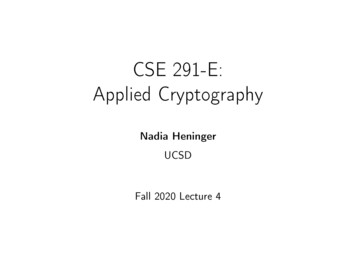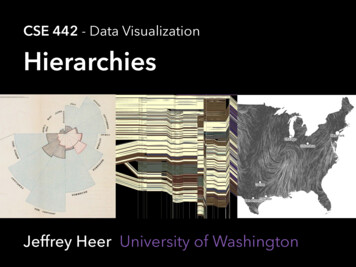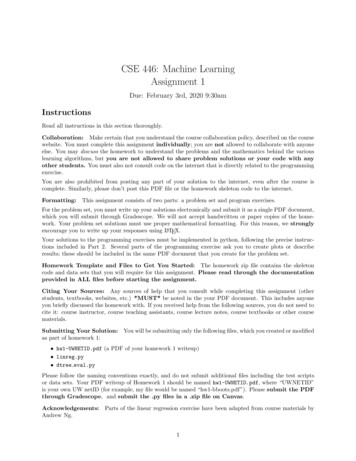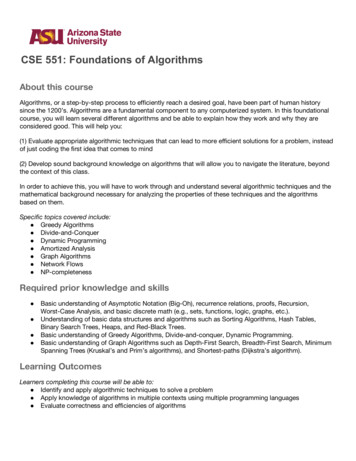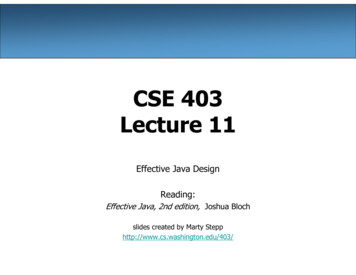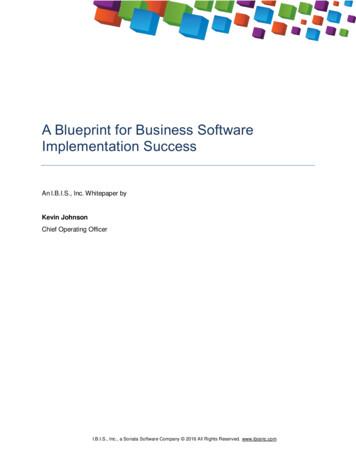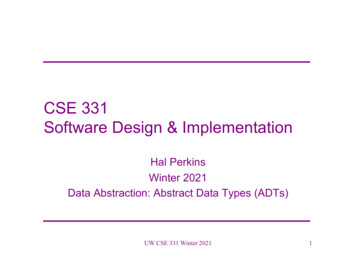
Transcription
CSE 331Software Design & ImplementationHal PerkinsWinter 2021Data Abstraction: Abstract Data Types (ADTs)UW CSE 331 Winter 20211
Administrivia HW3 due tomorrow night. When?11 PM pacific time!– Please double check correct tag and no gitlabrunner bugs, etc. Sections tomorrow: HW4 – implement rationalnumbers and related ADTs given a detailedspecification, verify with JUnit tests, and more – Assignment posted later today– Starter code for hw4 should be pushed to reposlater today or tonightUW CSE 331 Winter 20212
CommunicationsPlease help make this work Discussion board– Primary gathering place outside of class – help eachother out! Stay connected!– Fine to post anonymously– Post privately if question really is not appropriate toshare (questions about specific solutions, etc.) But we may ask your permission to change topublic (maybe anon.) if general interest– Not a general email service Email to cse331-staff for grading questions, personalissues, anything else that needs follow-up beyond aposted answer.UW CSE 331 Winter 20213
OutlineThis lecture:1. What is an Abstract Data Type (ADT)?2. How to specify an ADT? Immutable Mutable3. Design methodology for ADTsVery related next lectures: Representation invariants Abstraction functionsTwo distinct, complementary ideas for reasoning about ADTimplementationsUW CSE 331 Winter 20214
Procedural and data abstractionsProcedural abstraction:– Abstract from details of procedures (e.g., methods)– A specification mechanism– Satisfy the specification with an implementationData abstraction:– Abstract from details of data representation– Also a specification mechanism And a way of thinking about programs and design– Standard terminology: Abstract Data Type, or ADTUW CSE 331 Winter 20215
Outline of next 3 onbarrierAbstractdata typeTodayImplementation(e.g., Java class)Abstraction function (AF):Relationship between ADTspecification andimplementationUW CSE 331 Winter 2021Representation invariant (RI):Relationship amongimplementation fields6
Why we need Data Abstractions (ADTs)Organizing and manipulating data is pervasive– Inventing and describing algorithms is less commonStart your design by designing data structures– How will relevant data be organized– What operations will be permitted on the data by clients– Secondary: how is data stored/represented? Whatalgorithms manipulate the data?Potential problems with choosing a data abstraction:– Decisions about data structures often made too early– Duplication of effort in creating derived data– Very hard to change key data structures (modularity!)UW CSE 331 Winter 20217
An ADT is a set of operations ADT abstracts from the organization to meaning of dataADT abstracts from structure to useA type is a set of e, Operations are the only way clients can access dataRepresentation should not matter to the client– So hide it from the clientclass RightTriangle {private float base;private float altitude;}class RightTriangle {private float base;private float hypot;private float angle;}UW CSE 331 Winter 20218
An abstract data type defines a classof abstract objects which is completelycharacterized by the operationsavailable on those objects When a programmer makes use of anabstract data object, he [sic] isconcerned only with the behaviorwhich that object exhibits but not withany details of how that behavior isachieved by means of animplementation -- Programming with Abstract DataTypes, Barbara Liskov and StephenZilles 1974 (!)UW CSE 331 Winter 20219
Bad programmers worry aboutthe code. Good programmersworry about data structures andtheir relationships.-- Linus TorvaldsShow me your flowcharts andconceal your tables, and I shallcontinue to be mystified. Showme your tables, and I won’tusually need your flowcharts;they’ll be obvious.-- Fred BrooksUW CSE 331 Winter 202110
Are these classes the same?class Point {public float x;public float y;}class Point {public float r;public float theta;}Different: cannot replace one with the other in a programSame: both classes implement the concept “2-d point”Goal of ADT methodology is to express the sameness:– Clients depend only on the concept “2-d point”UW CSE 331 Winter 202111
Benefits of ADTsIf clients “respect” or “are forced to respect” data abstractions – For example, “it’s a 2-D point with these operations ” Can delay decisions on how ADT is implemented Can fix bugs by changing how ADT is implemented Can change algorithms– For performance– In general or in specialized situations We talk about an “abstraction barrier”– A good thing to have and not cross (also known as violate)UW CSE 331 Winter 202112
Concept of 2-d point, as an ADTclass Point {// A 2-d point exists in the plane, .public float x();public float y();Observerspublic float r();public float theta();// . can be created, .public Point(); // new point at (0,0)public Point centroid(Set Point points);Creators/Producers// . can be moved, .public void translate(float delta x,float delta y);public void scaleAndRotate(float delta r,float delta theta);Mutators}UW CSE 331 Winter 202113
Abstract data type objects operationsPointxyrthetatranslatescale rotrest ofprogramabstractionbarrierclientsimplementation Implementation is hidden The only operations on objects of the type are those provided bythe abstractionUW CSE 331 Winter 202114
Specifying a data abstraction An abstract state– Not the (concrete) representation in terms of fields, objects, Although some of the concrete state might coincide(implement directly) parts of the abstract state– “Does not exist” but used to specify the operations A collection of operations (procedural abstractions)– Not a collection of procedure implementations– Specified in terms of abstract state– No other way to interact with the data abstraction– Four types of operations: creators, observers, producers,mutatorsUW CSE 331 Winter 202115
Specifying an ADTImmutableMutable1.2.3.4.5.6.1.2.3.4.5.6. overviewabstract state abstract state (fields)creatorsobserversproducers (rare)mutatorsCreators: return new ADT values (e.g., Java constructors)Producers: ADT operations that return new ADT valuesMutators: Modify a value of an ADTObservers: Return information about an ADTUW CSE 331 Winter 202116
Implementing an ADTTo implement a data abstraction (e.g., with a Java class):– See next two lectures– This lecture is just about specifying an ADT– Nothing about the concrete representation appears in thespecificationUW CSE 331 Winter 202117
Poly, an immutable datatype: overview/*** A Poly is an immutable polynomial with* integer coefficients. A typical Poly is*c0 c1x c2x2 .**/class Poly {Abstract state (specification fields)Overview:– Always state whether mutable or immutable– Define an abstract model for use in operation specifications Difficult and vital! Appeal to math if appropriate Give an example (reuse it in operation definitions)– State in specifications is abstract, not concreteUW CSE 331 Winter 202118
Poly: creators// effects: makes a new Poly 0public Poly()// effects: makes a new Poly cxn// throws: NegExponent if n 0public Poly(int c, int n)Creators– New object, not part of pre-state: in effects, not modifies– Overloading: distinguish procedures of same name byparameters (Example: two Poly constructors)Footnote: slides omit full JavaDoc comments to save space; style mightnot be perfect either – focus on main ideasUW CSE 331 Winter 202119
Poly: observers// returns: the degree of this,//i.e., the largest exponent with a//non-zero coefficient.//Returns 0 if this 0.public int degree()// returns: the coefficient of the term//of this whose exponent is d// throws: NegExponent if d 0public int coeff(int d)UW CSE 331 Winter 202120
Notes on observersObservers– Used to obtain information about objects of the type– Return values of other types– Never modify the abstract value– Specification uses the abstraction from the overviewthis– The particular Poly object being accessed– Target of the invocation– Also known as the receiverPoly x new Poly(4, 3);int c x.coeff(3);System.out.println(c);// prints 4UW CSE 331 Winter 202121
Poly: producers// returns: this q (as a Poly)public Poly add(Poly q)// returns: the Poly equal to this * qpublic Poly mul(Poly q)// returns: -thispublic Poly negate()UW CSE 331 Winter 202122
Notes on producers Operations on a type that create other objects of the type Common in immutable types like java.lang.String– String substring(int offset, int len) No side effects– Cannot change the abstract value of existing objectsUW CSE 331 Winter 202123
IntSet, a mutable datatype:overview and creator// Overview:// unbounded// IntSet isclass IntSetAn IntSet is a mutable,set of integers. A typical{ x1, ., xn }.{// effects: makes a new IntSet {}public IntSet()UW CSE 331 Winter 202124
IntSet: observers// returns: true if and only if x Î thispublic boolean contains(int x)// returns: the cardinality of thispublic int size()// returns: some element of this// throws: EmptyException when size() 0public int choose()UW CSE 331 Winter 202125
IntSet: mutators// modifies: this// effects: thispost thispre È {x}public void add(int x)// modifies: this// effects: thispost thispre - {x}public void remove(int x)UW CSE 331 Winter 202126
Notes on mutators Operations that modify an element of the type Rarely modify anything (available to clients) other than this– List this in modifies clause (if appropriate) Typically have no return value– “Do one thing and do it well”– (Sometimes return “old” value that was replaced) Mutable ADTs may have producers too, but that is less commonUW CSE 331 Winter 202127
Next time Implementing ADTs– Picking concrete representations for dataabstractions (“the rep” – instance variables)– Reasoning about implementations: rep invariantsand abstraction functionsUW CSE 331 Winter 202128
Specifying an ADT Mutable 1. overview 2. abstract state (fields) 3. creators 4. observers 5. producers (rare) 6. mutators Immutable 1. overview 4. observers 5. producers 6. mutators Creators: return new ADT values (e.g., Java constructors) Producers: ADT operations that return new ADT val
